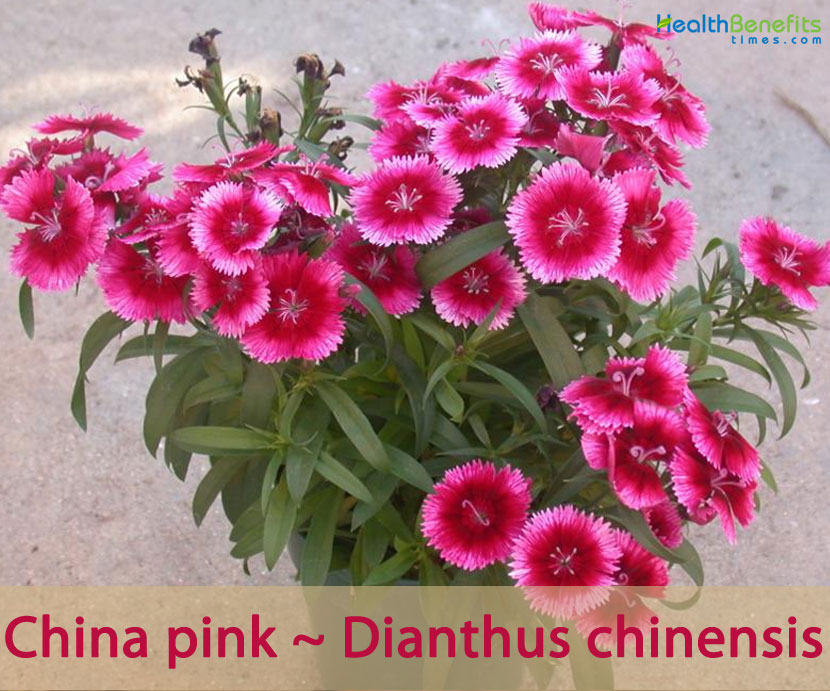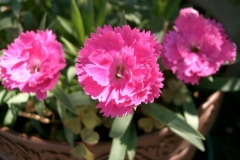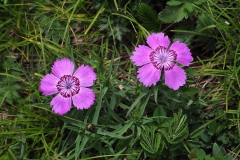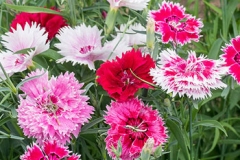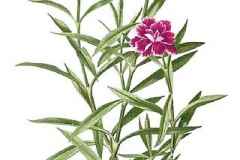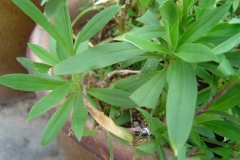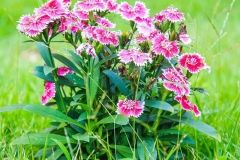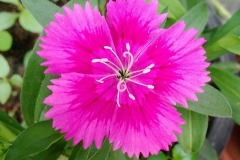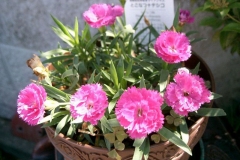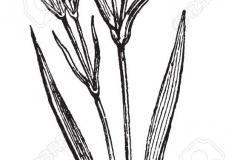| China pink Quick Facts | |
|---|---|
| Name: | China pink |
| Scientific Name: | Dianthus chinensis |
| Origin | Northern China, Korea, Mongolia, Kazakhstan and southeastern Russia |
| Shapes | Capsule, sub-sessile, ovoid-cylindrical, and dehiscing by 4 teeth |
| Health benefits | Beneficial for urinary tract infections (especially cystitis), urinary stones, constipation and failure to menstruate and to treat skin inflammations and swellings |
| Name | China pink |
|---|---|
| Scientific Name | Dianthus chinensis |
| Native | Northern China (Gansu, Hebei, Heilongjiang, Henan, Jilin, Liaoning, Nei Mongol, Ningxia, Qinghai, Shaanxi, Shandong, Shanxi and Xinjiang), Korea, Mongolia, Kazakhstan and southeastern Russia and has naturalized in southern China |
| Common Names | Annual Pink, China Pink, Chinese Pink, Dianthus, Pinks, French Mignonette, Indian Pink, Japanese Pink, Rainbow Pink |
| Name in Other Languages | Armenian: Mekhak ch’inakan (Մեխակ չինական) Azerbaijani: Çin qərənfili Basque: Txinatar krabelin Bulgarian: Kitaĭski karamfil (китайски карамфил) Burmese: Zaw-Hmwa-Gale Catalan: Clavell del Japó Chinese : Qú Mài, Shi Zhu (石竹), Jiǎn rónghuā (剪絨花), Luòyáng huā (洛陽花) Czech: Hvozdík, hvozdík čínský Danish: Kineser-nellike Dutch: Chinese anjer English: China pink, Indian pink, Japanese pink, Annual pink, Chinese Pink, Dianthus, Pink, Rainbow pink, Chinese pink, Estonian: Hiina nelk Euskera : Krabelin txinar Filipino: Clavel Finnish: Kiinanneilikka French : L’oeillet De La Chine, Oeillet de Chine, oeillet des poêtes German : Chinenser-Nelke, Kaiser-Nelke, Chinesische Nelke Japanese : Kara-Nadeshiko (カラナデシコ), Sekichiku (セキチク) Kalmyk: Bašr cecg (Башр цецг) Korean : Kara-Nadeshiko, paeraenikkot, paelaeng-ikkoch (패랭이꽃) Lithuanian: Kininis gvazdikas Norwegian: Kiinesernellik Philippines : Clavel Polish : Goździk Chiński Portuguese : Cravina-da-Arrábida, cravina-da-China, cravinhos-da-China, Cravina, Cravina-dos-jardins, Cravinha, Cravo, craveiro-da-china Russian: Gvozdika kitayskaya (гвозжика китайская) Spanish : Clavel Chino, Clavellina, clavel del Japón Swedish : Sommarnejlika Turkish : Çin Karanfili Ukrainian: Gvozdika kitayskaya (гвоздика китайська) Upper Sorbian: Chinska nalika |
| Plant Growth Habit | Small, glabrous, herbaceous, biennials or short-lived perennials garden plants |
| Growing Climates | Forest edges, forest grasslands, scrub on mountain slopes, hillside grasslands, dry hillsides, sandy hill summits, valleys, rocky ravines, meadows, stream sides, mountain stream wetlands, rocks, steppes, steppe sands, fixed dunes, seashores, sparse forests |
| Soil | Requires well-drained, neutral to slightly alkaline soil and full sun to partial shade |
| Plant Size | 30–50 cm high |
| Stem | Stem erect or ascending, branched dichotomously and distally, glabrous or sparsely pubescent with minute hairs, rootstock stout, short |
| Leaf | Leaves are green to greyish green, slender, 3–5 cm long and 2–4 mm broad. The basal leaves are usually already withered during flowering; the leaves remain on the stem |
| Flowering season | July to August |
| Flower | Flowers, 2.5–4 cm across, solitary or in a few flowered cymes with four ovate bracts and on 1–3 cm pedicels; calyx cylindric with lanceolate 5 mm, pointed teeth; petals 1.6–2 cm; limb bright red, purple-red, pink or white, obovate triangular, throat spotted and laxly bearded, apex irregularly dentate; stamens exserted; ovary sub oblong, style linear |
| Fruit Shape & Size | Capsule, sub-sessile, ovoid-cylindrical, and dehiscing by 4 teeth |
| Seed | Seeds are many, flattened-roundish, compressed dorsi-ventrally, blackish brown |
| Propagation | By seed |
| Season | August to September |
Plant Description
China pink is a small, glabrous, herbaceous, biennials or short-lived perennials garden plants that normally grows about 30–50 cm high. The plant is found growing in forest edges, forest grasslands, scrub on mountain slopes, hillside grasslands, dry hillsides, sandy hill summits, valleys, rocky ravines, meadows, stream sides, mountain stream wetlands, rocks, steppes, steppe sands, fixed dunes, seashores and sparse forests. The plant requires well-drained, neutral to slightly alkaline soil and full sun to partial shade. Stem is erect or ascending, branched dichotomously and distally, glabrous or sparsely pubescent with minute hairs, rootstock is stout and short.
Leaves
Leaves are simple, opposite, densely clustered near the base, linear lanceolate, about 3-5.5 cm long and 0.2-0.4 cm wide, base slightly connate, margin entire, thickened, apex acuminate, midrib thick, tri-nerved or penta-nerved. Radical leaves are about 5-6.5 cm long while cauline leaves are about 2-4 cm long, becoming smaller towards the apex, glabrous, petiole sessile. The leaves are green to greyish green colored. The basal leaves are usually already withered during flowering; the leaves remain on the stem.
Flower
Inflorescence usually occurs in terminal, few flowered or solitary. Flowers are bisexual, pedicel about 2-5 mm long, bracts 4, paired, ovate, margins scarious, bracteoles 4, broadly cuspidate, about half as long as calyx, with foliaceous points, calyx tubular or sub cylindrical, veins 7, without scarious commissures, apically 5 toothed, teeth triangular, with acuminate tip, margins ciliolate, scarious, about 8.5-11 mm long and 2-3.5 mm across, petals 5, free, spathulate-obovate, white, dark pink, purplish, base clawed, pubescent, auricles absent, margin acutely serrate, incurved, apex bifid, about 2.5-3.5 mm long. Stamens usually 10, filaments distinct, anthers 2-locular, dark blue or purplish, dorsifixed, staminodes absent, nectarines present. Ovary superior, unilocular, ovules numerous, staminodes absent, gynophore long, styles 2, filiform, stigmas. Flowering normally takes place in between July to August.
Fruit
Fertile flowers are followed by capsule, sub-sessile, ovoid-cylindrical, and dehiscing by 4 teeth, carpophores present. Seeds are many, flattened-roundish, compressed dorsi-ventrally, blackish brown, embryo erect, granulate.
Traditional uses and benefits of China Pink
- The Chinese pink has been used for over 3,000 years in Chinese herbal medicine.
- The whole plant is a bitter tonic herb that encourages the digestive and urinary systems and also the bowels.
- It is also anthelmintic, antibacterial, anti-phlogistic, diaphoretic, diuretic, emmenagogue, febrifuge and hemostatic.
- It is used internally in the treatment of acute urinary tract infections (especially cystitis), urinary stones, constipation and failure to menstruate and externally to treat skin inflammations and swellings.
- The old leaves are crushed and used for clearing eyesight.
- Qu Mai (dried aerial parts of Dianthus chinensis) is used in Chinese herbal medicine to promote urination and menstruation, to break up blood stasis and to treat red, sore and swollen eyes.
- This herb is used as a folk remedy for the treatment of menostasis, gonorrhea and cough and as a diuretic and emmenagogue in Korea.
- The plants are harvested just before the flowers open and are dried for later use.
Culinary Uses
- Like most Dianthus, it has a pleasant spicy, floral, clove-like taste and is ideal for decorating or adding to cakes.
- They also make a colorful garnish to soups, salads and the punch bowl.
- It is advisable to remove the bitter white base of the petal.
- Fresh dianthus petals added in liven up salads, sandwiches and pies.
- In addition, the petals of the flowers, when crystallized, make beautiful decorations for cakes and pastries.
Other Facts
- The species is popularly cultivated as an ornamental garden plant.
- It is excellent for beds, borders, edgings, rock gardens and pots.
Precautions
- Dianthus can stimulate the uterus, so you should not use it for pregnant or lactating females.
- Over dosage of dianthus can cause prolonged contractions of the uterus.
References:
https://www.itis.gov/servlet/SingleRpt/SingleRpt?search_topic=TSN&search_value=502028#null
https://npgsweb.ars-grin.gov/gringlobal/taxon/taxonomydetail?id=13827
https://pfaf.org/User/Plant.aspx?LatinName=Dianthus+chinensis
http://www.missouribotanicalgarden.org/PlantFinder/PlantFinderDetails.aspx?kempercode=a574
http://www.narc.gov.jo/gringlobal/taxonomydetail.aspx?id=13827
http://www.efloras.org/florataxon.aspx?flora_id=2&taxon_id=200007038
http://www.theplantlist.org/tpl1.1/record/kew-2764027
http://www.theplantlist.org/tpl1.1/record/kew-2764027
https://plants.usda.gov/home/plantProfile?symbol=DIANT
https://gd.eppo.int/taxon/DINCH
https://en.wikipedia.org/wiki/Dianthus_chinensis
https://indiabiodiversity.org/species/show/229512


